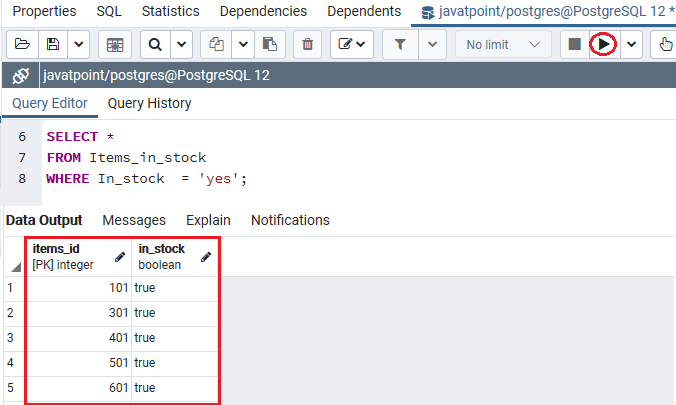

#Postgres in clause code#
( 'D', 500, NULL) Code language: SQL (Structured Query Language) ( sql ) Second, we insert some records into the items table using INSERT statement as follows: INSERT INTO items (product, price, discount)

See the following examples: SELECT COALESCE ( 1, 2) Code language: SQL (Structured Query Language) ( sql ) SELECT COALESCE ( NULL, 2, 1) Code language: SQL (Structured Query Language) ( sql ) MySQL has IFNULL function, while Oracle provides NVL function. The COALESCE function provides the same functionality as NVL or IFNULL function provided by SQL-standard. All the remaining arguments from the first non-null argument are not evaluated. The COALESCE function evaluates arguments from left to right until it finds the first non-null argument. If all arguments are null, the COALESCE function will return null. It returns the first argument that is not null. The COALESCE function accepts an unlimited number of arguments. The syntax of the COALESCE function is as follows: COALESCE (argument_1, argument_2, …) Code language: SQL (Structured Query Language) ( sql )
#Postgres in clause how to#
You will learn how to apply this function in SELECT statement to handle null values effectively. If you find the article helpful, don’t hesitate to share it with your friends and family.Summary: in this tutorial, you will learn about the PostgreSQL COALESCE function that returns the first non-null argument. You can use subqueries in all the CRUD operations of SQL – INSERT, SELECT, UPDATE, and DELETE. However, subqueries are not limited to the SELECT statement only. This article showed you what you need to know about SQL subqueries and how to use them with the SELECT statement. WHERE name IN ('Denis Jack', 'Ola Ajayi', 'Uche Ugo') To show you that you can really use multiple values inside the WHERE clause with the help of the IN statement, I got the wage of some employees with known names by running this query: SELECT name, wage FROM employees SELECT name, country, wage FROM employees The IN statement lets you use multiple values inside a WHERE clause. To get the wage of the employees from the USA, including their names and country, I combined the WHERE clause with the IN statement. WHERE wage < (SELECT AVG(wage) FROM employees) To adjust the query so I can get data of the employees earning less than the average wage, we only need to change the greater than symbol (>) to less than (<): SELECT * FROM employees So, the query and subquery helped us get all the employees with a wage more than the average wage of 1250.0000. You can see the average wage is 1250.0000. To show you the average wage, in particular, I could run only the subquery: the WHERE clause I specified ( WHERE wage >) was responsible for getting every employee with a salary less than the average wage.the subquery ( SELECT AVG(wage) FROM employees) got the average wage of the employees.the main query selected everything from the employees table.WHERE wage > (SELECT AVG(wage) FROM employees) To get the data of those earning more than the average wage, I ran the following query and subquery: SELECT * FROM employees Running SELECT * FROM employees gives me the following table: I’ll be working with an employees table in an employees_data database. How to Use SQL Subqueries with the Select Statement In this article, you will learn how to use subqueries inside the SELECT statement.

Even if you know the value, you can still use a subquery to get more data about the value. You usually put subqueries inside brackets and you can use them with comparison operators such as =,, =.Ī valid use case of a subquery is using it with the SELECT statement when you don’t know the exact value in the database. SQL admins usually use subqueries inside the WHERE clause to narrow down the result of the main query (or outer query). The outer query in which the inner query is inserted is the main query. So, in SQL, a subquery is also called a nested query or an inner query. A SQL subquery is a query inside a query.


 0 kommentar(er)
0 kommentar(er)
